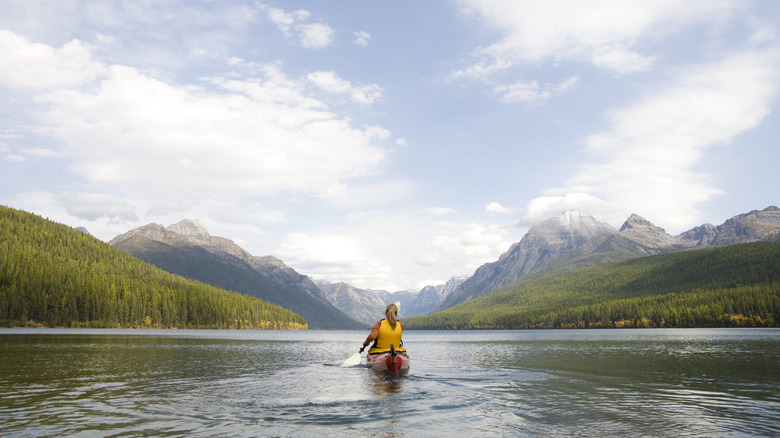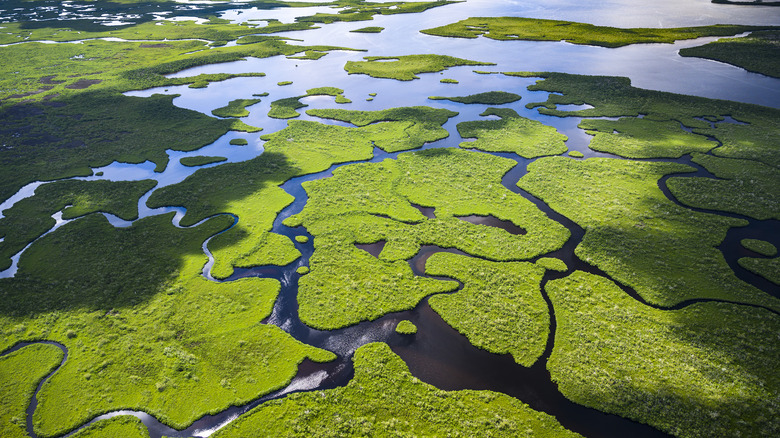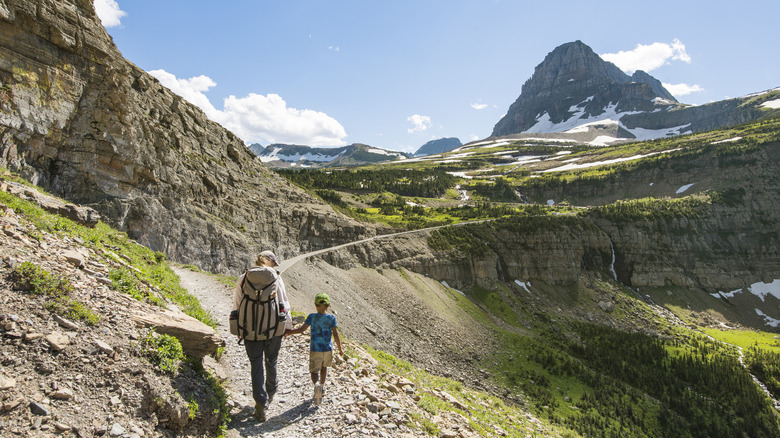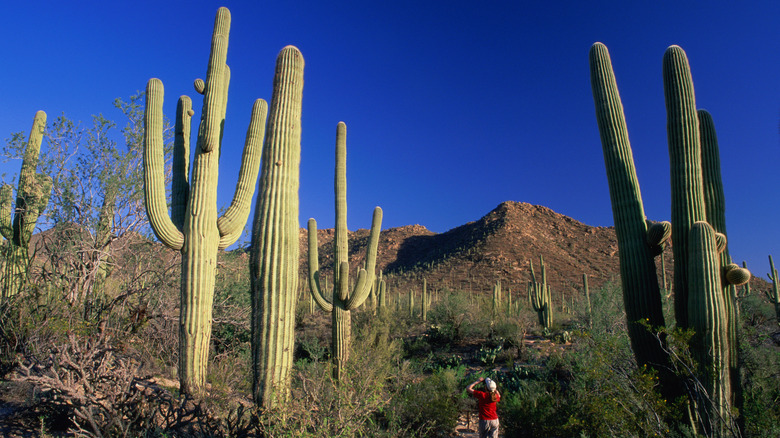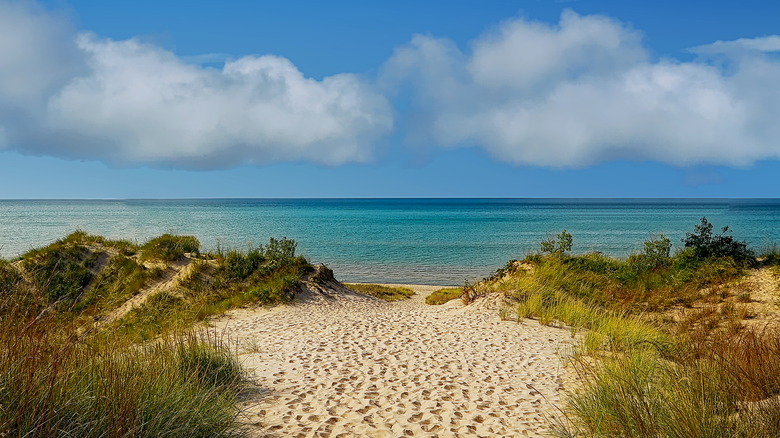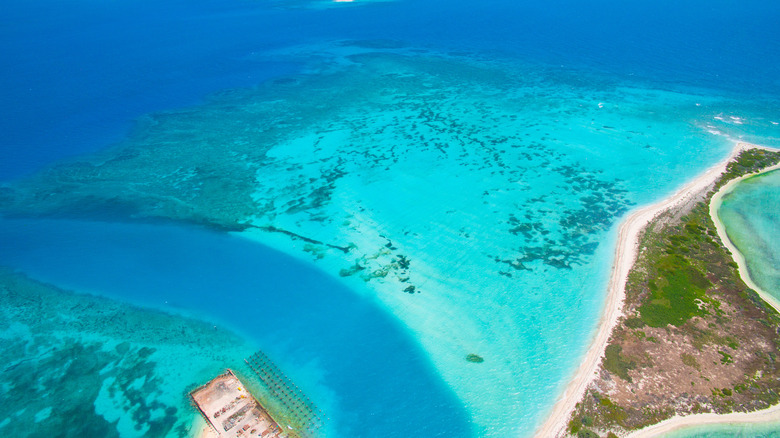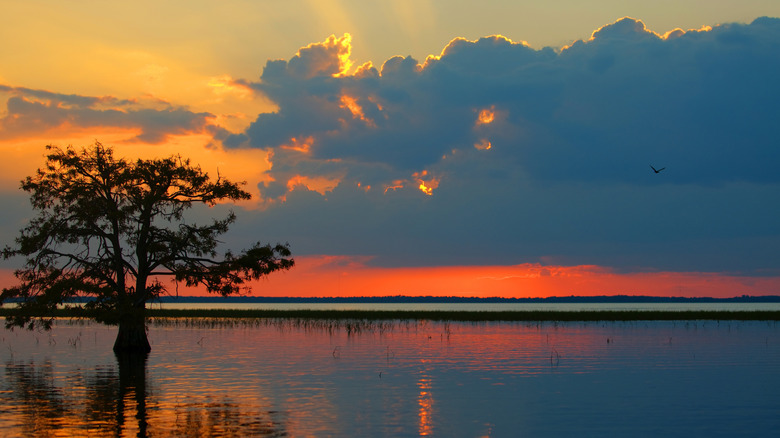The 5 Most Endangered National Parks In America, According To Research
The story of America's national parks began in 1872 when President Ulysses S. Grant established the Yellowstone National Park Protection Act. Since then, the U.S. government has been protecting vast swaths of the natural landscape by creating 61 national parks that keep conditions pristine and accessible to hikers and nature lovers. National park status prevents these areas from being exploited for their natural resources, but that doesn't necessarily mean that gates and entrance fees can keep out other environmental threats.
Climate change stands to vastly alter and endanger the current condition of America's national parks, whether it be physical changes you can see, like melting glaciers and wildfires, or invisible ones like the effects of spring arriving earlier each year. Add in extreme weather, sea level rise, and even the consequences of overtourism as more and more people get out to the parks, and it's clear that these beautiful parks are facing a lot of challenges. Unfortunately, some national parks are in more trouble than others.
Here are five of the most endangered national parks, according to official sources such as the National Park Service (NPS), the Environmental Protection Agency (EPA), and the National Park Conversation Association (NPCA).
Everglades National Park
While most people associate Florida with busy beaches and amusement parks, this state is actually home to the largest subtropical wilderness in the country. The only place in the world where you can see wild alligators and crocodiles in the same spot, Everglades National Park is so much more than just swamplands. It also sits at one of the frontiers of the fight against climate change.
In addition to the threat of sea level rise, there are more and more powerful hurricanes battering down the state of Florida every year. According to the EPA, this means that the park also faces issues like degrading water quality caused by stormwater runoff. This affects the wetlands' rich biodiversity, including over 360 species of birds and endangered species like the American crocodile and the Florida panther. Urban development also threatens the park's survival as the growing population in South Florida is reported to be taking more and more water from the Everglades.
Glacier National Park
Located in northern Montana, Glacier National Park is known as the crown of the continent. It's named for the 80 glaciers that were found in the area at the end of the Little Ice Age, which ended in 1850. There were just 26 glaciers left in 2015, according to the NPS. Even this number might be generous today, the organization writes, as some of the remaining ice may now be too small to fit the definition of a glacier. This devastating change is something that has even been witnessed from space, and NASA modeling in the 1990s predicted that all the park's glaciers could disappear by the year 2030. However, the NPS said making a prediction like this is more complicated than the software suggested at the time.
While the EPA reports that "warming temperatures and other changes are melting the park's alpine glaciers," it also specifies that it's not just melting ice we have to worry about. "Such changes have implications not only for tourism, but also for the ecosystems, animals, and people that depend on glacier-fed streamflow." Climate change also puts the park at higher risk for wildfires, and less snow disrupts the way of life for many of the park's residents, like the mountain goats and wolverines.
Saguaro National Park
Glacier isn't the only national park whose namesake is under threat. Just outside of Tucson, Arizona, Saguaro National Park is an Arizona gem with breathtaking scenery in a beautiful Sonoran desert landscape characterized by its giant cacti, which can grow up to heights of 40 feet. However, according to the NPS, changing climate patterns are threatening the young Saguaros' chances of survival. The NPS also reports that the park's natural springs are producing less water, and drought conditions have increased the frequency of wildfires.
While many native plants and animals struggle to adapt, the conditions are perfect for the spread of buffelgrass, an invasive species not native to North America. The NPS calls it "the archenemy of the Sonoran desert" because it can easily take over and damage the existing ecosystem, and provides the kindling for wildfires to spread widely in the park. "Invasive plants, such as buffelgrass, fill in the spaces between native plants, exponentially increasing fire danger," the NPS explains on its website. "Desert fires can harm habitat and kill saguaros and other natives not adapted to fire.
Indiana Dunes National Park
With 15,000 acres of dunes at this underrated park on Lake Michigan, about 40 miles from Chicago, Indiana Dunes National Park is one of the country's newest national parks. It graduated from Indiana Dunes National Lakeshore to National Park status in 2019. It's a place where people come to sunbathe on the shore, play among the shifting mounds of sand, and hike along the wetland trails. Despite its new status, the national park is endangered by nearby pollution and erosion, according to the NPCA. The agency lists the park in its Polluted Parks report, and cites some of the biggest threats as poor air quality and the invasive emerald ash borer, a beetle that attacks the park's native ash trees.
As per the park's official website, pollution isn't the only threat facing Indiana Dunes, and increased rainfall is causing major changes to the shore front with one-fifth of the lakeshore being classified as "highly vulnerable."
Dry Tortugas National Park
National Parks are not always on land, and, in fact, this exotic escape in the Gulf of Mexico also happens to be one of the best islands to visit in Florida. Situated 70 miles off of Key West, 99% of the park is underwater, which doesn't exactly make it easy to visit without scuba gear — although there are seven small islands you can get to by seaplane or ferry.
Many people prefer to experience the island by diving below the surface to see the colorful reefs and sea turtles, but rising ocean temperatures and sea level rise are dramatically affecting the park. As per an NPS case study, rising sea levels and more storms are threatening the park's historic sites like Fort Jefferson, the park's operation base. Under the sea, the National Oceanic and Atmospheric Administration (NOAA), is monitoring the effect of rising temperatures and ocean acidification in the park. This is a huge concern as the NPCA points out in a 2024 blog post: "Just last summer, hot tub temperatures made headlines as 40% of the world's oceans experienced a marine heat wave and mass coral bleaching." Thankfully, according to research by the U.S. Geological Survey, the corals surrounding Dry Tortugas may be benefiting from natural resilience.
How we determined the most endangered national parks in America
Year after year, catastrophic weather events and record-breaking temperatures remind us that climate change is a reality. To determine the most endangered national parks in America, we considered which parks are struggling the most with various environmental challenges that range from pollution and sea-level rise to wildfires and biodiversity loss.
Consulting multiple reports across government agencies like the EPA and the NPCA, and resources from the National Park Service, we identified some of the most at-risk parks facing a variety of issues and listed them here, in no particular order. This research includes data from studies on the loss of ice in Glacier National Park conducted by the USGS and NPCA reports like the Polluted Parks report, which ranks national parks based on air climate conditions. We also cross-referenced these reports with multiple media outlets, noting some of the national parks most cited as endangered national parks, and with issues highlighted on the NPS website to find the latest plans to mitigate climate threats, such as the Indiana Dunes Climate Change Adaptation Plan.
